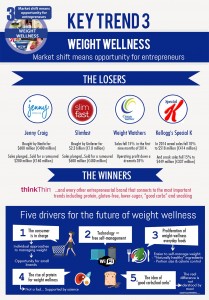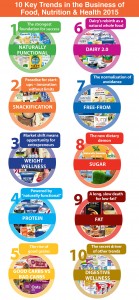New opportunities emerge as weight wellness hits tipping point, predicts New Nutrition Business
The weight wellness market is at a tipping point, and in 2015 big 
name brands like Weight Watchers will continue to see sales plunge – even Special K, the world’s biggest food for weight management, has experienced a sudden 10% drop in sales.
According to 10 Key Trends in Food, Nutrition and Health 2015, the new food and health trend forecast from New Nutrition Business, while big businesses struggle, small entrepreneurial brands will find a wealth of opportunities in everyday foods for Weight Wellness (Key Trend 3).
“Consumers are switching to regular foods to maintain weight wellness, which is creating a wealth of opportunities for big brands and entrepreneurs alike,” says Julian Mellentin, author of the report. 10 Key Trends is the only forecast to focus solely on food, nutrition and health trends and what they mean for industry.
“People’s desire to maintain a healthy weight and a trim figure is the biggest influence on the key trends in food and health, driving many of the trends in this report,” he says. “Improving digestive health and avoiding a bloated stomach to maintain a good figure are key reasons why people adopt, for example, a gluten-free or lower-gluten diet, avoiding refined carbs and trying to consume more good grains.”
High-protein foods (Key Trend 4) in particular have benefited from their link with weight management. Protein is an easy ingredient for people to understand, it’s natural, backed by science and it has a long-standing association with maintaining a healthy figure.
The idea of “good carbs and bad carbs” (Key Trend 5) has taken hold among the most health-conscious consumers. The number of people reducing carbohydrates for weight management is small but growing – and already having an effect on sales of grain-based products. Big brands such as Cheerios have experienced sales falls of 5%. Sales of “good grains” – such as oats and the so-called ancient grains – are soaring. Sprouted grains are a surprise winner, with one small snack brand jumping from zero to $25 million in three years.
Sugar has become the new dietary demon (Key Trend 8) – replacing fat and salt – and this spotlight on sugar content has created a challenge for food companies, who are wrestling with how to meet expectations of lower sugar and boost business. Lowering sugar content has produced some clear winners in the kids market, but no one has yet figured out how to make this work in the adult market.
Consumer interest in free-from foods is increasing (Key Trend 7) – and the biggest area is gluten-free, which is not a passing fad but an increasingly important aspect of all new product development, with even Nestle launching gluten-free cornflakes. The 25% of consumers who are motivated by gluten-free are not totally eliminating but reducing their gluten, perhaps eating it two-to-three days a week.
The long slow death of low-fat (Key Trend 9): People are beginning to understand that eating fat doesn’t make you fat. But although research is revealing that fat is not the enemy of health we thought it was, consumer change will be slow. Younger consumers are the group most likely to change their habits around fat.
Dairy is enjoying a renaissance (Key Trend 6): Dairy is emerging as a big winner of changing perceptions of fat – US butter sales have overtaken table spreads as people get “permission to indulge” in more traditional dairy products. Dairy’s image is getting a boost as science both refutes negatives around dairy fats and uncovers more about the positive effects of dairy consumption.
Marketing products that have “naturally functional” ingredients and benefits (Key Trend 1) remains the “king of trends”, as it has been since 2005: Naturally functional is an innovation strategy and it is behind many of the biggest successes such as Greek yoghurt, coconut water and almonds.
SPOT THE DIFFERENCE BETWEEN A TREND AND A FAD 
“Many things are put forward as trends, but we select only those that are long-term drivers for our industry,” says Mellentin. “This long-term focus allows both brand and ingredient companies to formulate meaningful strategies.”
What the Key Trends mean for brands: The 10 Key Trends present a mass of innovation and renovation opportunities for both big brands and entrepreneurial brands. The most successful products and brands connect to multiple trends – even if the connection is a secondary positioning for the brand rather than a primary positioning.
What the Key Trends mean for ingredient suppliers: In today’s competitive market ingredient companies must be as knowledgeable about the final consumer as their customers are. Ingredient suppliers need to know which trends their ingredients connect to, because how well connected they are will dictate how successful they are going to be.
“Understanding the key trends will help ingredient companies to create applications and marketing messages that will enable their customers to create successful brands,” says Mellentin.


































